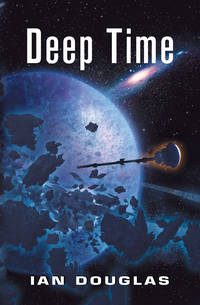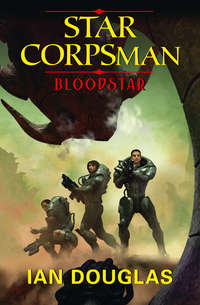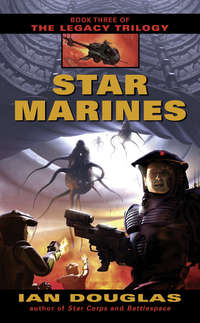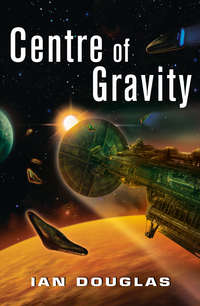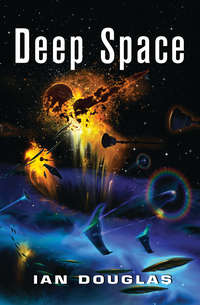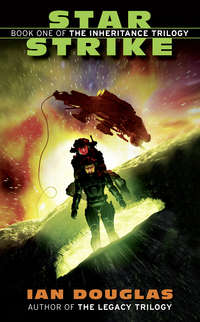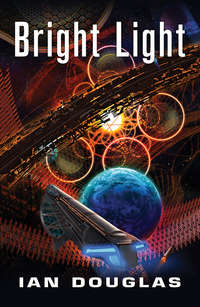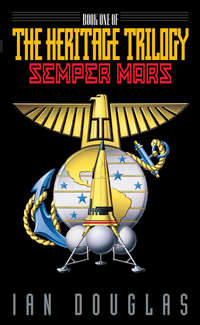
Полная версия
The Star Carrier Series Books 1-3: Earth Strike, Centre of Gravity, Singularity

Ian Douglas
The Star Carrier Series Books 1–3

Table of Contents
Cover
Title Page
Earth Strike
Centre of Gravity
Singularity
Extract from Deep Space
By Ian Douglas
About the Author
Copyright
About the Publisher
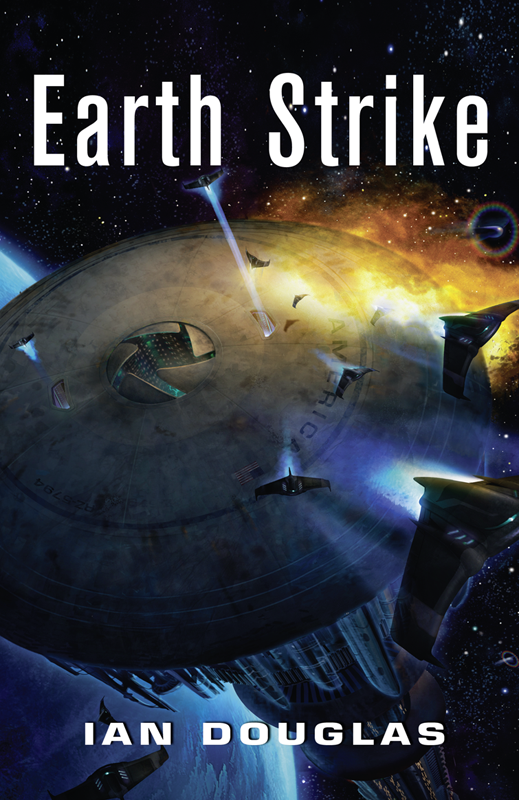
“Too little, too late, I fear. We have lost the planet, either way.”
He dipped his gravfighter’s nose and accelerated.
He wasn’t quite “down to the deck,” as he’d reported, but close enough. The Starhawk was dropping now past the twenty-kilometer mark. The sky above was still space-dark, the brightest stars—Arcturus, especially—still gleaming and brilliant, but the cloud decks below rose thick and towering, their tops sculpted by high-altitude winds and tinted red and gold by the rising sun. He’d crossed enough of the planet’s face that the local sun was well above the horizon now, casting long, blue-purple shadows and hazy shafts of golden light across the distinctly three-dimensional surface of the cloudscape below.
Gray adjusted his ship’s hull-form again, sculpting it for high-speed aerial flight, absorbing the deep entry keel and extending the wings farther and deeper into their forward-canted configuration. Behind him, a sudden burst of shooting stars marked another cloud of sand or debris entering atmosphere, a barrage of silent flick-flick-flicks of light.
He let his AI target on the Marine beacon, bringing the SG-92’s prow left across the horizon, then dipping down into a plunging dive. He opened his com suite to the Marine frequency and began sending out an approach vector clearance request.
He hadn’t crossed seventy-one AUs and survived a near-miss by a thermonuke to get shot down by the damned jarheads.
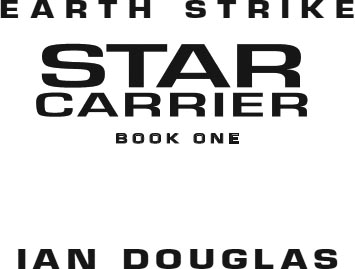

For Brea, who has seen me through many, many light years
Table of Contents
Too little, too late, I fear
Title Page
Dedication
Author’s Note
Prologue
Chapter One
Chapter Two
Chapter Three
Chapter Four
Chapter Five
Chapter Six
Chapter Seven
Chapter Eight
Chapter Nine
Chapter Ten
Chapter Eleven
Chapter Twelve
Chapter Thirteen
Chapter Fourteen
Chapter Fifteen
Chapter Sixteen
Chapter Seventeen
Chapter Eighteen
Chapter Nineteen
Chapter Twenty
Chapter Twenty-One
Chapter Twenty-Two
Chapter Twenty-Three
Chapter Twenty-Four
Chapter Twenty-Five
Epilogue
Copyright
Author’s Note
Readers of the Galactic Marines series may wonder at first why the background for Earth Strike seems so different from the universe of Heritage, Legacy, and Inheritance. Where are the Xul, the Builders, the Marine Corps families and traditions extending across two millennia?
There’s a simple explanation. Earth Strike is the opening volley of a completely new military-SF series, Star Carrier, which explores the lives of Navy combat fighter pilots of the far future. Welcome aboard the Star Carrier America as she faces a new and deadly threat to Earth and all of humankind.
I hope you enjoy the cruise!
Ian Douglas
December 2009
Prologue
25 September 2404
TC/USNA CVS America
Emergence, Eta Boötean Kuiper Belt
32 light years from Earth
0310 hours, TFT
The sky twisted open in a storm of tortured photons, and the Star Carrier America dropped through into open space.
She was … enormous, by far the largest mobile construct ever built by humankind, a titanic mushroom shape, the kilometer-long stem shadowed behind the immense, hemispherical cap that was both reaction mass and radiation shielding. Her twin counter-rotating hab rings turned slowly in the shadows. Swarms of probes and recon ships emerged from her launch tubes, minnows streaking out into wan sunlight from the bulk of a whale.
Around her, the other vessels of the America Battlegroup emerged from the enforced isolation of metaspace as well, some having bled down to sublight velocities minutes before, others appearing moment by moment as their emitted and reflected light reached America’s sensors. Some members of the battlegroup had scattered as far as five AUs from the star carrier in realspace, and would not again rejoin her communications net for as much as forty more minutes.
The ship’s pitted and sandblasted forward shield caught the wan glow of a particularly brilliant star—the sun of this system nearly seventy-one astronomical units distant. The data now flooding America’s sensors were almost nine and a half hours old.
Within his electronic cocoon on the America’s Combat Information Center, the Battlegroup Commander linked in through the ship’s neural net, watching the data scroll past his in-head display.
STAR: Eta Boötis
COORDINATES: RA: 13h 54m 41.09s Dec: +18? 23’ 52.5” D 11.349p
ALTERNATE NAMES: Mufrid, Muphrid, Muphride, Saak, Boötis 8 (Flamsteed)
TYPE: GO IV
MASS: 1.6 Sol; RADIUS: 2.7 Sol; LUMINOSITY: 9 Sol
SURFACE TEMPERATURE: ~6100oK
AGE: 2.7 billion years
APPARENT MAGNITUDE (SOL): 2.69; Absolute magnitude: 2.38
DISTANCE FROM SOL: 37 ly
BINARY COMPANION: White dwarf, mean orbit: 1.4 AU; period: 494 d
PLANETARY SYSTEM: 14 planets, including 9 Jovian and sub-Jovian bodies, 5 rocky/terrestrial planets, plus 35 dwarf planets and 183 known satellites, plus numerous planetoids and cometary bodies …
Rear Admiral Alexander Koenig was, in particular, interested in the planetary data for just one of the worlds circling that distant gold-hued star: Eta Boötis IV, known formally as Al Haris al Sama, informally as Haris, and more often and disparagingly within the fleet as “Ate a Boot.”
“God,” he said as he watched the planetary data unfold. “What a mess.”
America’s AI did not reply, having learned long ago that human statements of surprise or disgust generally did not require a reply.
Eta Boötis IV was not even remotely Earthlike in atmosphere or environment—greenhouse-hot with a deadly, poisonous atmosphere—a wet Venus, someone had called it. What the Arabs had seen in the place when they put down a research station there was anybody’s guess.
As the America’s computer net built up models of the sensor data, it became clear that the enemy fleet was already there, as expected, orbiting the planet—or, rather, that they’d been there when the electromagnetic radiation and neutrinos emitted by them had begun the journey over nine hours ago. It was a good bet that they were there still, circling in on Gorman’s Marines. America’s delicate sensors could detect the hiss and crack of EMP—the telltale fingerprints of nuclear detonations and particle beam fire—even across the gulf of more than seventy AUs.
“All stations, we have acquired Objective Mike-Red,” the fleet commander said. “Launch ready-one fighters.”
The America had a long reach indeed.
And now she was going to prove it.
Chapter One
25 September 2404
VFA-44 Dragonfires
Eta Boötis System
0311 hours, TFT
Lieutenant Trevor Gray watched the numbers dwindle from ten to zero on his IHD, as the Starhawk’s AI counted them off. He was in microgravity at the moment, deep within the carrier’s hub core, but that would be changing very soon, now.
“Three …” the female voice announced, a murmur in his ear, “two … one … launch.”
Acceleration pressed him back into the yielding foam of his seat, a monster hand bearing down on chest and lungs until breathing deeply was nearly impossible. At seven gravities, vision dimmed…
… then flashed back as the crushing sensation of weight abruptly vanished. It took the Starhawk 2.39 seconds to traverse the two-hundred-meter cat-launch tube, and as it emerged into open space it was traveling at just over 167 meters per second relative to the drifting America.
“Blue Omega Seven, clear,” he announced.
“Omega Eight, clear,” another voice echoed immediately. Lieutenant Katie Tucker, his wing, was somewhere off his starboard side, launched side-by-side with him through the twin launch tubes.
He brought up an aft view in time to see the rapidly receding disk of the America’s shield cap dwindling away at over six hundred kilometers per hour. In seconds, the dull, silver-white shield had fallen astern to a bright dot … and then even that winked out, vanished among the stars. Icy and remote, those stars gleamed hard and unblinking across night; the other fighters of VFA-44, even the other capital ships of the Confederation fleet, all were lost in dark emptiness.
“Imaging, full view forward.”
The view from his SG-92 Starhawk’s cockpit was purely digital illusion, of course. At his command, the aft view projected across the curving inner surface of his cockpit vanished, replaced by different stars. One, directly ahead, gleamed with an intense golden brilliance—the local sun, though it was too distant to show a disk.
To port and low, another gold-red star shone almost as brilliantly—twice as bright as Venus at its brightest, seen from Earth. That, Gray knew from his briefings, was the star Arcturus, just three light years away.
Arcturus, however, was not his problem. Not anymore.
And not yet.
“Imaging,” he said. “Squadron ships.”
Green-glowing, diamond-shaped icons appeared on the stellar panorama, above, below, and to the left, each attended by a string of alphanumerics giving ship number and pilot id, and Gray felt just a little less lonely. Eight other Starhawks besides his drifted in the void out there, their AIs nudging them now into a ring ten kilometers across. As the minutes passed, three more strike-fighters moved up from astern, taking their places with the squadron.
The formation was complete.
“Okay, chicks,” Commander Marissa Allyn said over the squadron comnet. She was VFA-44’s CO, and Flight Leader for this op. “Configure for high-G.”
Each of the Starhawks had emerged from the diamagnetic launch tubes in standard flight configuration, a night-black needle shape twenty meters long, with a central bulge housing the pilot and control systems, and the mirror-smooth outer hull in a superconducting state. At Gray’s command, his gravfighter began reshaping itself, the complex nanolaminates of its outer structure dissolving and recombining, drive units and weapons and sensors folding up and out and back, everything building up around the central bulge in a blunt and smoothly convoluted egg-shape with a slender spike tail off the narrow end, and with the fat end aligned with the distant, golden gleam of Eta Boötis.
“Blue Omega Leader, Omega Seven,” he reported. “Sperm mode engaged. Ready for boost.” Gravfighter pilots claimed their craft looked like huge spermatozoa when they were in boost configuration. His Starhawk was now only seven meters long—not counting the field bleed spike astern—and five wide, though it still massed twenty-two tons.
“America CIC, this is Alpha Strike Blue Omega One,” Allyn said. “Handing off from PriFly. All Blues clear of the ship and formed up. Ready to initiate PL boost.”
“Copy, Blue Omega One,” a voice replied from America’s Combat Information Center. “Primary Flight Control confirms handoff to America CIC. You are clear for high-grav boost.”
“Acknowledge squadron clear for boost,” Allyn said. “Don’t forget about us out there, America.”
“Don’t worry, Blue Omega. We’ll be on your asses all the way in.”
That wasn’t quite true, Gray thought. According to the operations plan, the task force would be following, but it would be another eighteen hours, total, before they reached the target planet.
The squadron would be on its own until then.
“Blue Omega Strike, Omega One,” Allyn said over the squadron’s tac channel. “Engage squadron taclink.”
Gray focused a thought, and felt an answering sensation of pressure in the palm of his left hand. The twelve fighter craft were connected now by laser-optic comnet feeds linking their on-board AIs into a single electronic organism.
“And gravitic boost at fifty kay,” Allyn continued, “in three … two … one … punch it!”
A gravitational singularity opened up immediately ahead of Gray’s Starhawk.
He was falling.
In fact, he was accelerating now at fifty thousand gravities, falling toward the artificial singularity projected ahead of his gravfighter, but since the high-G field affected every atom of the Starhawk and of Lieutenant Gray uniformly, he was not reduced to a thin organic smear across the aft surfaces of the cockpit. In fact, he felt nothing whatsoever beyond the usual and somewhat pleasant falling sensation of zero gravity.
Outwardly, there was no indication that within the first ten seconds of engaging the gravitic drive, he was traveling at five hundred kilometers per second relative to the America, his speed increasing by half a million meters per second with each passing second. The stars remained steady and unmoving, unwinking in the night.
After one minute he’d be traveling at three thousand kilometers per second, or 1 percent of the speed of light.
And in ten minutes he’d be pushing hard against c itself.
In strike fighter combat, speed is everything.
CIC, TC/USNA CVS America
Eta Boötean Kuiper Belt
0312 hours, TFT
Admiral Alexander Koenig watched the slowly growing green sphere of local battlespace, now four light minutes across and still growing. Perhaps half of Battlegroup America was accounted for now. The others were out there, but scattered so far by the uncertainties of pinpoint navigation across interstellar distances that the information heralding their emergence from metaspace wouldn’t arrive for some time yet.
The America’s Combat Information Center, located just aft of the bridge, was large, but had a tightly packed, almost cluttered feel. Located at the carrier’s hub, it was designed to function in microgravity. CIC personnel were tucked into workstations that let them link electronically with the ship and with other stations. Curving bulkheads and the shallow dome of the overhead displayed seamless images of the sky surrounding the huge ship, relayed from CCD scanners on the rim of the shield cap forward. The local space display was on the stage at the center of the compartment, just below Koenig’s station. By moving his hand within the glowing and insubstantial console projected in front of him, he could rotate the sphere and enlarge a portion of it, checking the ID alphanumerics.
Altogether, some twenty-seven ships made up the task force, including heavy cruisers and a battleship, four destroyers, half a dozen frigates, a small flotilla of supply and repair vessels, and a detachment of eight troop transports, all empty. Of all of those, only nine ships were linked in so far.
Ah! Good. The railgun cruiser Kinkaid was visible now, two light minutes abeam, at 184 degrees relative. They would need the Kinky’s massive kinetic-kill firepower if this op degenerated into a fleet action … and Koenig was certain that it would. And the destroyers Kaufman and Puller were on-line now as well. They would be vital if—no, when—the Turusch va Sh’daar spotted the battlegroup and deployed their heavy fighters to meet it.
That made eleven so far.
A gangly, long-legged shadow swam across the scattering of stars against the overhead dome, backlit by the gold gleam of Eta Boötis. John Quintanilla, the battlegroup’s Political Liaison, floated upside-down, from Koenig’s perspective, clinging to the back of the admiral’s couch.
“Shouldn’t we be accelerating or something?” the civilian asked.
“Not until the rest of the battlegroup forms up with us,” Koenig replied.
“Your orders from the Senate Military Directorate,” Quintanilla said, his voice low, “require you to reach Gorman’s force in the shortest time possible. Time is critical! He can’t hold out very much longer.”
“I am very much aware of that, Mr. Quintanilla.”
“Those fighters you launched aren’t going to have much of a chance against a Turusch war fleet. Your orders—”
“My orders, Mr. Quintanilla,” Koenig snapped, “include the requirement to keep my battlegroup intact … or as intact as combat allows.” Koenig moved his hand, calling up an AI-generated image of the planet nine and a half light hours ahead, outlined in green lines of latitude and longitude. “We will not help General Gorman if we piss away the ships of this battlegroup a few at a time!”
“But—”
“This is what’s waiting for us in there, Mr. Quintanilla,” Koenig said, interrupting. The sphere at the center of the CIC display enlarged sharply, and a number of red pinpoints sprang into sharp relief against the green background. Each red dot was accompanied by alphanumerics showing mass, vector, and probable id.
“Fifty-five vessels that we’ve been able to detect so far,” Koenig told him. “So far. There are, no doubt, others on the far side of the planet that we haven’t picked up as yet. We will be seriously outnumbered in this engagement, sir, and I will not divide my fleet in the face of a superior enemy!”
Most of the enemy ships were in orbit around the planet, but a few were farther out, decelerating as they backed down in their approach vectors. The Turusch had definitely arrived in force.
“You know what is best, of course,” Quintanilla said, his face stiff, expressionless. “At least from a tactical perspective. My job is simply to remind you of the … of the political ramifications of your decisions. General Gorman is an extremely important person in the Senate’s estimation. They want him rescued and returned safely.”
Koenig made a face. He detested politics, and he detested playing politics with brave men and women. “Ah. And Gorman’s Marines?”
“Of course, the more Marines you can pick up, the better.”
“I see. And the Mufrids?”
Quintanilla gave him a sharp look. “Certainly, any of the colonists for which you have transport berths can be brought out, especially any with information on Turusch capabilities. But I’ll remind you that General Gorman’s rescue is your prime consideration.”
“I know my orders, Mr. Quintanilla,” Koenig said, his voice cold. “Now … if you’ll excuse me …”
He moved his hand in his workstation’s control field, and the electronic image of Eta Boötis IV vanished again, replaced by the map sphere of space immediately surrounding America and her consorts. More ships were popping up on the display’s expanding battlespace globe, including the Ticonderoga and The Spirit of Confederation, the first a heavy cruiser, the second the task force’s single line-battleship, with heavy kinetic-kill railguns that could pulverize a planet.
Unfortunately, the Confederation task force could not pulverize the planet ahead, not without killing some five thousand Marines of the 1st Marine Expeditionary Force and the colonists they’d been deployed to protect.
Quintanilla floated above Koenig’s workstation for a moment longer, then grunted, pushed himself off from the couch, and drifted toward the CIC entrance behind the command dais.
Located beneath Koenig’s station was the section of the CIC known as “the orchestra pit” and, more usually, simply as “the pit.” Twelve workstations nestled within the pit, where America’s CIC officers stood their watches. One of them, Commander Janis Olmstead, the primary weapons control officer, caught Koenig’s eye and arched an eyebrow. “Since when did micromanagement become Navy SOP, sir?” she asked.
“Mind on your links, Weps,” Captain Randolph Buchanan’s electronic avatar said. He was America’s commanding officer, and Koenig’s flag captain. Physically, he was on the bridge next door to CIC, but the compartment’s electronics projected his image to the command dais next to Koenig’s couch.
“Yes, sir. Sorry, sir.”
“She’s right, you know,” Koenig told Buchanan, but he texted the words to Buchanan’s screen, rather than speaking them aloud. He would not criticize Buchanan’s running of his ship and crew, not publicly. “It’s not going to be the Sh’daar that defeat us. Or their client races. It’s going to be the damned Confed politics.”
Out of the corner of his eye, he saw Buchanan’s image scowl as the captain read the words on a screen.
“Agreed, Admiral.” The words appeared silently on one of Koenig’s screens a moment later. “I have to tell you, sir, I don’t like this.”
“No,” Koenig typed back. “But we play by the rules we’re given.”
Buchanan seemed to hesitate, and then the avatar looked at Koenig. “How the hell do we fight a galactic empire, Admiral?” he asked aloud.
Damn. Buchanan should have kept the conversation private, exchanging text messagers. Glancing down into the pit, Koenig could see that Olmstead and the others were carefully watching their own link channels and displays, but they’d obviously heard. The conversation would spread throughout the America before the end of the next watch.
“I don’t believe in ‘galactic empires,’” Koenig said. He snorted. “The whole idea is silly, given the size of the galaxy.”
“Well, the Sh’daar appear to believe in the concept, Admiral,” Buchanan’s image said. “And I doubt very much that it matters whether they agree with you on the point or not.”
“When the Sh’daar show themselves,” Koenig replied carefully, “if they show themselves, we’ll worry about galactic empires. Right now, our concern is with the Turusch.”
It had been ninety-two years since humankind had made contact with the Sh’daar, or, more precisely, since they’d made first contact with the Aglestch va Sh’daar, one of an unknown but very large number of technic alien species within what was somewhat melodramatically called the Sh’daar Galactic Empire. Quite early on, the Aglestch—some humans still referred to them as “Canopians,” even though that brilliant, hot F0-class supergiant could not possibly be their home star—had explained that they served the “Galactic Masters,” the Sh’daar.


